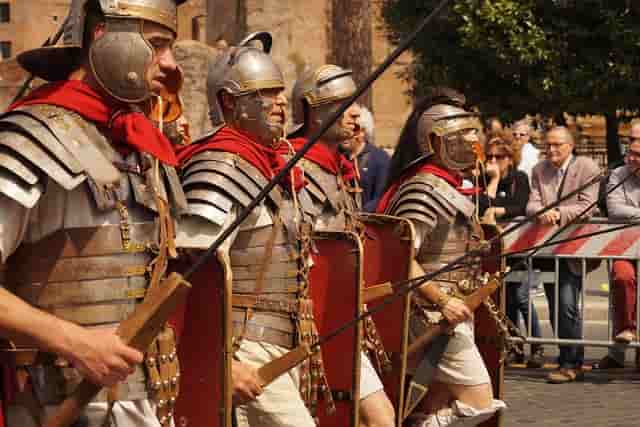The popular media portrays Julius Caesar is often depicted as a towering persona with a powerful presence. What exactly was the height of Caesar’s time as a Roman governor and statesman?
While there aren’t precise measurements about his height, historical sources give some clues that provide insight into the physical characteristics of Caesar.
In this blog, we’ll explore the historical sources of Caesar’s height and attempt to paint a picture of the man who inspired the myth.
How tall was Julius Caesar according to historical Records ?

Julius Caesar is one of the most famous figures in the history of the world. He is famous for his military accomplishments as well as his political savvy, and tragic death. Although much is known about his accomplishments and his legacy, One question that has long fascinated experts and historians is: how high was Julius Caesar? The answer to this issue is obscure since there is no specific evidence of his height. However, using various sources and historical records, it is possible to make informed estimations.
It is crucial to remember that standards for height have changed dramatically throughout the ages and that what was considered tall and short in early Rome might differ from contemporary standards. To give some background, the average height of an average Roman male in Julius Caesar’s reign was about 5’5″ (165cm). This average height was affected by factors like diet, genetics, and general health. It is possible that those with higher social status, such as Julius Caesar, may have had a higher status than the average person.
A relic from the past that provides information about Julius Caesar’s height is the account written by Roman historian Suetonius. In his narrative of the time, Suetonius described Julius Caesar as “short, fat, balding, with a full neck and piercing eyes.” Although Suetonius’s biography was composed some time after Caesar’s death, there is a chance that he had access to previous sources or personal stories that influenced this portrayal. Based on this evidence, it’s plausible to conclude that Julius Caesar was below average height according to modern standards, maybe 5’4″ (163cm) (or even shorter).
But other sources from the past give different descriptions of Caesar’s appearance. For instance, Plutarch, the Roman historian, said the following: Caesar was “tall, of good physique, with a fair complexion and shapely limbs.” This implies that Caesar was of average or higher height, possibly around 5’9″ (175cm) or more. Furthermore, some contemporary historians have pointed out evidence of Caesar’s physical ability, like his ability on horseback, as evidence that he could be taller than the average.
However, despite the different sources, it is probable that Julius Caesar’s height was in the range of 5’4″ (163cm) and 5’9″ (175cm). In the absence of a specific measurement of his height, it’s impossible to say with certainty. In the end, even though the issue about the size of Julius Caesar’s body remains unanswered, his legacy as a leader in the military, statesman, and historical persona remains awe-inspiring and captivating people from all over the world.
Debate and Controversy over Julius Caesar’s Height

There is debate and even controversy regarding Julius Caesar’s height, with some historians asserting that he was a bit small for his time while others claim that he was average height or even higher than average.
The main evidence used to calculate Caesar’s height comes from old writings and paintings. Certain sources, like Suetonius, the Roman writer, mention Caesar as “short and stocky.” It’s also important to remember that the earliest descriptions of height typically utilized relative terms instead of precise measurements. What could have been considered tall or short in one time period may not be so in the next.
Furthermore, some historians believe that depicting Caesar as a short man may be a deliberate effort to diminish his physical power and authority, given that his height was frequently associated with power and authority in early Rome.
Other evidence, like the life-size stone statue depicting Caesar from the early second century AD, indicates that he was approximately 5′ 7″ inches (170 centimeters) tall and was probably more or less average for a man of the period.
The average height of a Roman soldier

The size of Roman soldiers is also a subject of fascination for historians and researchers. Although there isn’t exact evidence of the size of the average Roman soldier, there are numerous sources that offer some insights into the matter.
One of the sources is Roman historian Polybius, who claimed in his diary that the Roman army was adamant about those who were “not too tall or too short.” Polybius stated the ideal height of the ideal Roman soldier was 5’6″ (167cm) which was slightly higher in comparison to the average height of an average Roman citizen.
Other sources from the past have offered differing estimates. For instance, one of the sources is that the Roman poet Virgil said that the Trojan hero Aeneas, who was thought to be an example of Roman morality and military skill and strength, was “taller than the rest” of his fellow soldiers. This suggests that being taller could be considered an advantage during battle, and taller soldiers could be preferred in certain circumstances.
Alongside these accounts from the past, modern anthropological research has given some insight into the physical traits that characterized Roman soldiers. For instance, a study of bones found in Roman military sites revealed that the average height of soldiers of the male gender was 5’7″ (170 cm), which was just a bit taller than the normal height for males in the period.
What is the average height of a man in ancient Rome?
The average height of a man living in ancient Rome is believed to have been around 5 feet, 6 inches (167.6 centimeters). It is important to keep in mind that this estimation is based on a limited amount of evidence, like measurements of skeletons and paintings, and is therefore not 100% accurate.
Was height an important factor in ancient Roman society?
Height was not considered as important a factor in ancient Roman society as it is in some modern cultures. While there was a preference for physical strength and fitness, particularly among the upper classes who valued military prowess, height was not necessarily seen as a defining characteristic of masculinity or social status.
Other factors such as wealth, social status, and education were considered more important in determining a man’s place in ancient Roman society. That being said, there is evidence to suggest that taller individuals were often preferred for certain roles, such as gladiators, who were expected to be physically imposing and impressive to spectators.
Conclusion
The exact height of Julius Caesar is still a matter of dispute and uncertainty for historians and fans.
Although there isn’t a definitive record of his height in ancient sources, many other descriptions of his physical appearance suggest that he was either short or tall. These accounts suggest that Julius Caesar was between 5’4 and 5’9.
Other Links:-










Information article
thank you!
Well researched information 👍
Yaah ! according to historical Records everyone have different perspectives
you can learn here in detail
A little mistake. Suetonius does not describe Julius Caesar as such.
The Twelve Caesars by Suetonius; Gaius Julius Caesar chapter, Robert Graves translation: Caesar is said to have been tall, fair, and well-built, with a rather broad face and keen, dark-brown eyes. [45]
“Thank you for pointing that out! I appreciate the correction. You’re absolutely right, and I apologize for any confusion. In the ‘The Twelve Caesars’ by Suetonius, in the Gaius Julius Caesar chapter, the Robert Graves translation indeed describes Caesar as tall, fair, and well-built, with a rather broad face and keen, dark-brown eyes. [45] I’m grateful for your attention to detail!”